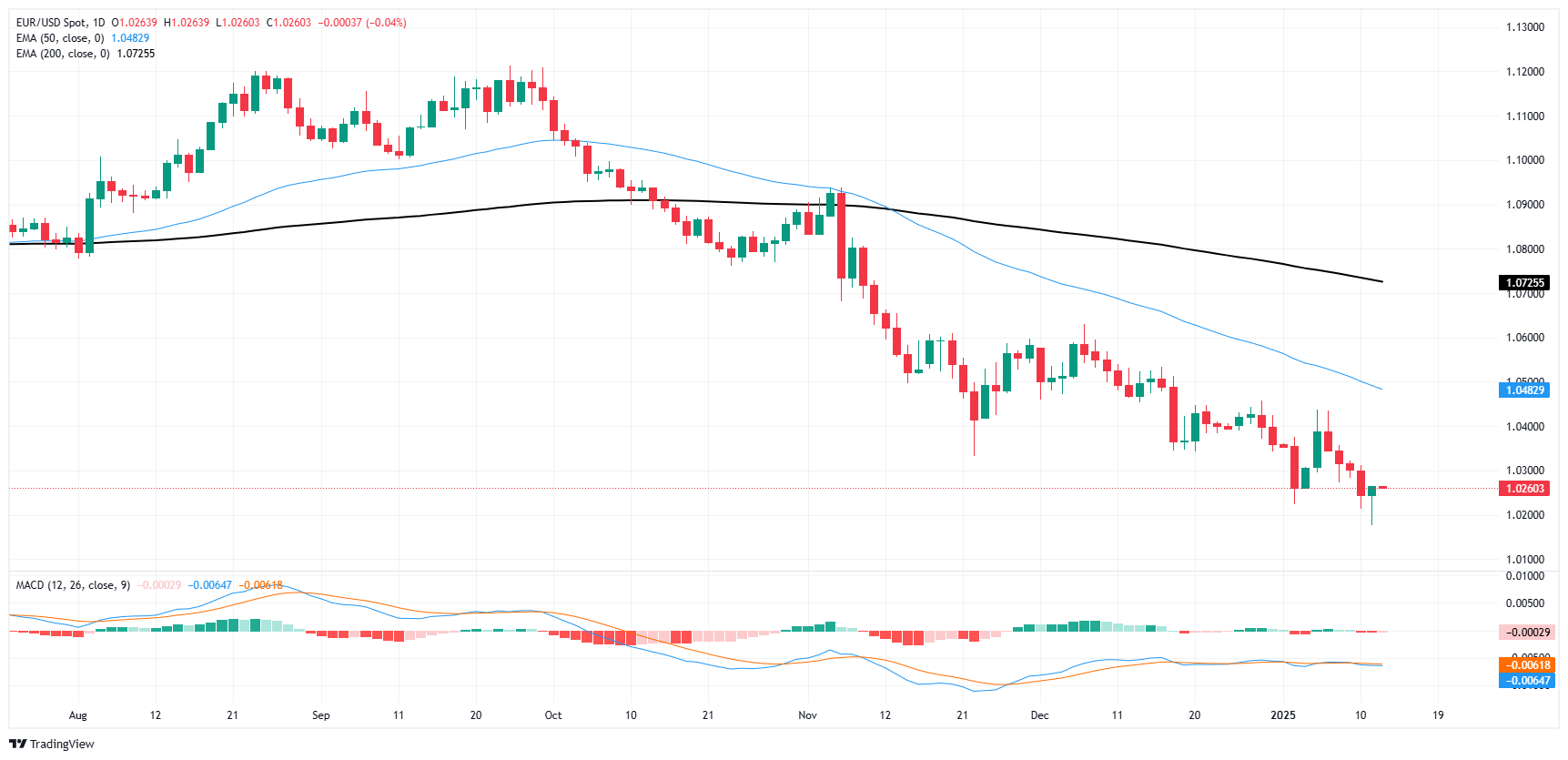EUR/USD scrambles to recover ground after fresh test of two-year lows
- EUR/USD tapped the 1.0200 handle for the first time in over two years on Monday.
- European final inflation figures are due this week, but are unlikely to move the needle.
- It’s the Greenback’s ballgame to lose this week with key US inflation figures on the data docket.
EUR/USD continued to explore the bearish side of the charts on Monday, declining into the 1.0200 handle for the first time since late 2022, etching in a fresh 26-month low before staging half-hearted recovery later in the day.
European economic data remains tepid throughout the trading week. The European Central Bank (ECB) is set to continue reducing interest rates, further widening the Euro’s interest rate differential against the US Dollar. Pan-ERU and German final inflation due through the midweek sessions are not expected to deviate significantly from their preliminary prints.
US Producer Price Index (PPI) figures kick the week’s meaningful data docket off on Tuesday, which is expected to rise to 3.7% YoY in December versus the previous 3.4%. US CPI inflation, also due on Wednesday, is forecast to tick higher to 2.8% from 2.7%, and US Retail Sales activity is slated for Thursday.
EUR/USD price forecast
EUR/USD continues to plumb the depths of recent bearish momentum, and Fiber is on pace to chalk in a fourth consecutive losing month. The pair has tested the 1.0200 handle for the first time in a little over two years, but the one-sided nature of price action on EUR/USD leaves downside breaks as a sign of continued bearish momentum rather than firm signs of a potential turnaround.
EUR/USD daily chart
Euro FAQs
The Euro is the currency for the 19 European Union countries that belong to the Eurozone. It is the second most heavily traded currency in the world behind the US Dollar. In 2022, it accounted for 31% of all foreign exchange transactions, with an average daily turnover of over $2.2 trillion a day. EUR/USD is the most heavily traded currency pair in the world, accounting for an estimated 30% off all transactions, followed by EUR/JPY (4%), EUR/GBP (3%) and EUR/AUD (2%).
The European Central Bank (ECB) in Frankfurt, Germany, is the reserve bank for the Eurozone. The ECB sets interest rates and manages monetary policy. The ECB’s primary mandate is to maintain price stability, which means either controlling inflation or stimulating growth. Its primary tool is the raising or lowering of interest rates. Relatively high interest rates – or the expectation of higher rates – will usually benefit the Euro and vice versa. The ECB Governing Council makes monetary policy decisions at meetings held eight times a year. Decisions are made by heads of the Eurozone national banks and six permanent members, including the President of the ECB, Christine Lagarde.
Eurozone inflation data, measured by the Harmonized Index of Consumer Prices (HICP), is an important econometric for the Euro. If inflation rises more than expected, especially if above the ECB’s 2% target, it obliges the ECB to raise interest rates to bring it back under control. Relatively high interest rates compared to its counterparts will usually benefit the Euro, as it makes the region more attractive as a place for global investors to park their money.
Data releases gauge the health of the economy and can impact on the Euro. Indicators such as GDP, Manufacturing and Services PMIs, employment, and consumer sentiment surveys can all influence the direction of the single currency. A strong economy is good for the Euro. Not only does it attract more foreign investment but it may encourage the ECB to put up interest rates, which will directly strengthen the Euro. Otherwise, if economic data is weak, the Euro is likely to fall. Economic data for the four largest economies in the euro area (Germany, France, Italy and Spain) are especially significant, as they account for 75% of the Eurozone’s economy.
Another significant data release for the Euro is the Trade Balance. This indicator measures the difference between what a country earns from its exports and what it spends on imports over a given period. If a country produces highly sought after exports then its currency will gain in value purely from the extra demand created from foreign buyers seeking to purchase these goods. Therefore, a positive net Trade Balance strengthens a currency and vice versa for a negative balance.
